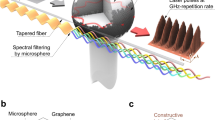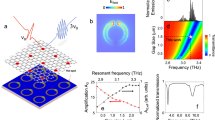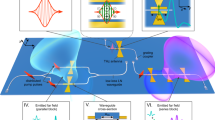Abstract
The generation of stable trains of ultrashort (femtosecond to picosecond), terahertz-frequency radiation pulses with large instantaneous intensities is an underlying requirement for the investigation of light–matter interactions for metrology and ultrahigh-speed communications. In solid-state electrically pumped lasers, the primary route to generate short pulses is through passive mode-locking; however, this has not yet been achieved in the terahertz range, defining one of the longest standing goals over the past two decades. In fact, the realization of passive mode-locking has long been assumed to be inherently hindered by the fast recovery times associated with the intersubband gain of terahertz lasers. Here we demonstrate a self-starting miniaturized short pulse terahertz laser, exploiting an original device architecture that includes the surface patterning of multilayer-graphene saturable absorbers distributed along the entire cavity of a double-metal semiconductor 2.30–3.55 THz wire laser. Self-starting pulsed emission with 4.0-ps-long pulses is demonstrated in a compact, all-electronic, all-passive and inexpensive configuration.
This is a preview of subscription content, access via your institution
Access options
Access Nature and 54 other Nature Portfolio journals
Get Nature+, our best-value online-access subscription
$29.99 / 30 days
cancel any time
Subscribe to this journal
Receive 12 print issues and online access
$209.00 per year
only $17.42 per issue
Buy this article
- Purchase on Springer Link
- Instant access to full article PDF
Prices may be subject to local taxes which are calculated during checkout




Similar content being viewed by others
Data availability
The data presented in this study are available on reasonable request from the corresponding author.
Code availability
The relevant computer codes supporting this study are available from the authors on reasonable request.
References
Haus, H. A. Mode-locking of lasers. IEEE J. Sel. Top. Quantum Electron. 6, 1173–1185 (2000).
Perego, A. M. et al. Coherent master equation for laser modelocking. Nat. Commun. 11, 311 (2020).
Cundiff, S. T. & Ye, J. Phase stabilization of mode-locked lasers. J. Mod. Opt. 52, 201–219 (2005).
Du, T. et al. 1.2-W Average-power, 700-W peak-power, 100-ps dissipative soliton resonance in a compact Er:Yb co-doped double-clad fiber laser. Opt. Lett. 42, 462–465 (2017).
Tang, W. et al. High-peak-power mode-locking pulse generation in a dual-loss-modulated laser with BP-SA and EOM. Opt. Lett. 42, 4820–4823 (2017).
Rausch, S. et al. Controlled waveforms on the single-cycle scale from a femtosecond oscillator. Opt. Express 16, 9739–9745 (2008).
Zewail, A. H. Femtochemistry: atomic-scale dynamics of the chemical bond. J. Phys. Chem. A 104, 5660–5694 (2000).
Hänsch, T. W. Nobel Lecture: Passion for precision. Rev. Mod. Phys. 78, 1297–1309 (2006).
Fortier, T. & Baumann, E. 20 years of developments in optical frequency comb technology and applications. Commun. Phys. 2, 1–16 (2019).
Keller, U. et al. Semiconductor saturable absorber mirrors (SESAM’s) for femtosecond to nanosecond pulse generation in solid-state lasers. IEEE J. Sel. Top. Quantum Electron. 2, 435–453 (1996).
Komarov, A., Leblond, H. & Sanchez, F. Passive harmonic mode-locking in a fiber laser with nonlinear polarization rotation. Opt. Commun. 267, 162–169 (2006).
Haus, H. A., Fujimoto, J. G. & Ippen, E. P. Structures for additive pulse mode locking. JOSA B 8, 2068–2076 (1991).
Lu, H., Xu, H., Zhao, J. & Hou, D. A deep ultraviolet mode-locked laser based on a neural network. Sci Rep. 10, 116 (2020).
Qin, Z. et al. Black phosphorus Q-switched and mode-locked mid-infrared Er:ZBLAN fiber laser at 3.5 μm wavelength. Opt. Express 26, 8224–8231 (2018).
Fülöp, J. A., Tzortzakis, S. & Kampfrath, T. Laser-driven strong-field terahertz sources. Adv. Opt. Mater. 8, 1900681 (2020).
Gollner, C. et al. Highly efficient THz generation by optical rectification of mid-IR pulses in DAST. APL Photon. 6, 046105 (2021).
Vinokurov, N. Free electron lasers as a high-power terahertz sources. J. Infrared Millim. Terahertz Waves 32, 1123–1143 (2011).
Vitiello, M. S. & Tredicucci, A. Physics and technology of Terahertz quantum cascade lasers. Adv. Phys. X 6, 1893809 (2021).
Khalatpour, A. et al. Terahertz semiconductor laser source at −12 C. Preprint at https://doi.org/10.48550/arXiv.2211.08125 (2022).
Wang, F. et al. Short terahertz pulse generation from a dispersion compensated modelocked semiconductor laser. Laser Photon. Rev. 11, 1700013 (2017).
Barbieri, S. et al. Coherent sampling of active mode-locked terahertz quantum cascade lasers and frequency synthesis. Nat. Photon. 5, 377–377 (2011).
Bachmann, D. et al. Short pulse generation and mode control of broadband terahertz quantum cascade lasers. Optica 3, 1087 (2016).
Wang, F. et al. Ultrafast response of harmonic modelocked THz lasers. Light: Sci. Appl. 9, 51 (2020).
Piccardo, M. & Capasso, F. Laser frequency combs with fast gain recovery: physics and applications. Laser Photon. Rev. 16, 2100403 (2022).
Riepl, J. et al. Field-resolved high-order sub-cycle nonlinearities in a terahertz semiconductor laser. Light: Sci. Appl. 10, 246 (2021).
Derntl, C. G. et al. Gain dynamics in a heterogeneous terahertz quantum cascade laser. Appl. Phys. Lett. 113, 181102 (2018).
Tzenov, P. et al. Passive and hybrid mode locking in multi-section terahertz quantum cascade lasers. New J. Phys. 20, 053055 (2018).
Henry, N., Burghoff, D., Hu, Q. & Khurgin, J. B. Study of spatio-temporal character of frequency combs generated by quantum cascade lasers. IEEE J. Sel. Top. Quantum Electron. 25, 1–9 (2019).
Wang, C. Y. et al. Mode-locked pulses from mid-infrared quantum cascade lasers. Opt. Express 17, 12929–12943 (2009).
Kuizenga, D. & Siegman, A. FM and AM mode locking of the homogeneous laser—part I: theory. IEEE J. Quantum Electron. 6, 694–708 (1970).
Prati, F. et al. Soliton dynamics of ring quantum cascade lasers with injected signal. Nanophotonics 10, 195–207 (2021).
Meng, B. et al. Dissipative Kerr solitons in semiconductor ring lasers. Nat. Photon. 16, 142–147 (2022).
Neu, J. & Schmuttenmaer, C. A. Tutorial: an introduction to terahertz time domain spectroscopy (THz-TDS). J. Appl. Phys. 124, 231101 (2018).
Talukder, M. A. & Menyuk, C. R. Self-induced transparency modelocking of quantum cascade lasers in the presence of saturable nonlinearity and group velocity dispersion. Opt. Express 18, 5639 (2010).
Choi, H. et al. Ultrafast Rabi flopping and coherent pulse propagation in a quantum cascade laser. Nat. Photon. 4, 706–710 (2010).
Li, L. et al. Broadband heterogeneous terahertz frequency quantum cascade laser. Electron. Lett. 54, 1229–1231 (2018).
Garrasi, K. et al. High dynamic range, heterogeneous, terahertz quantum cascade lasers featuring thermally tunable frequency comb operation over a broad current range. ACS Photon. 6, 73–78 (2019).
Bianchi, V. et al. Terahertz saturable absorbers from liquid phase exfoliation of graphite. Nat. Commun. 8, 15763 (2017).
Brida, D. et al. Ultrafast collinear scattering and carrier multiplication in graphene. Nat. Commun. 4, 1987 (2013).
Tomadin, A., Brida, D., Cerullo, G., Ferrari, A. C. & Polini, M. Nonequilibrium dynamics of photoexcited electrons in graphene: collinear scattering, Auger processes, and the impact of screening. Phys. Rev. B 88, 035430 (2013).
Paiella, R. et al. Self-mode-locking of quantum cascade lasers with giant ultrafast optical nonlinearities. Science 290, 1739–1742 (2000).
Hafez, H. A. et al. Terahertz nonlinear optics of graphene: from saturable absorption to high-harmonics generation. Adv. Opt. Mater. 8, 1900771 (2020).
Consolino, L. et al. Fully phase-stabilized quantum cascade laser frequency comb. Nat. Commun. 10, 1–7 (2019).
Mezzapesa, F. P. et al. Terahertz frequency combs exploiting an on-chip, solution-processed, graphene-quantum cascade laser coupled-cavity. ACS Photon. 7, 3489–3498 (2020).
Burghoff, D., Yang, Y., Reno, J. L. & Hu, Q. Dispersion dynamics of quantum cascade lasers. Optica 3, 1362 (2016).
Oustinov, D. et al. Phase seeding of a terahertz quantum cascade laser. Nat. Commun. 1, 69 (2010).
Beiser, M., Opačak, N., Hillbrand, J., Strasser, G. & Schwarz, B. Engineering the spectral bandwidth of quantum cascade laser frequency combs. Opt. Lett. 46, 3416–3419 (2021).
Opačak, N., Cin, S. D., Hillbrand, J. & Schwarz, B. Frequency comb generation by Bloch gain induced giant Kerr nonlinearity. Phys. Rev. Lett. 127, 093902 (2021).
Cavalié, P. et al. High order sideband generation in terahertz quantum cascade lasers. Appl. Phys. Lett. 102, 221101 (2013).
Gallot, G., Zhang, J., McGowan, R. W., Jeon, T.-I. & Grischkowsky, D. Measurements of the THz absorption and dispersion of ZnTe and their relevance to the electro-optic detection of THz radiation. Appl. Phys. Lett. 74, 3450–3452 (1999).
Tzenov, P., Burghoff, D., Hu, Q. & Jirauschek, C. Time domain modeling of terahertz quantum cascade lasers for frequency comb generation. Opt. Express 24, 23232–23247 (2016).
Jirauschek, C., Riesch, M. & Tzenov, P. Optoelectronic device simulations based on macroscopic Maxwell–Bloch equations. Adv. Theory Simul. 2, 1900018 (2019).
Silvestri, C., Columbo, L. L., Brambilla, M. & Gioannini, M. Coherent multi-mode dynamics in a quantum cascade laser: amplitude- and frequency-modulated optical frequency combs. Opt. Express 28, 23846–23861 (2020).
Haus, H. A. Theory of mode locking with a fast saturable absorber. J. Appl. Phys. 46, 3049–3058 (1975).
Pogna, E. A. A. et al. Hot-carrier cooling in high-quality graphene Is intrinsically limited by optical phonons. ACS Nano 15, 11285–11295 (2021).
Sun, Z. et al. Graphene mode-locked ultrafast laser. ACS Nano 4, 803–810 (2010).
Choi, H. et al. Gain recovery dynamics and photon-driven transport in quantum cascade lasers. Phys. Rev. Lett. 100, 167401 (2008).
Mezzapesa, F. P. et al. Tunable and compact dispersion compensation of broadband THz quantum cascade laser frequency combs. Opt. Express 27, 20231–20240 (2019).
Kurtner, F. X., der Au, J. A. & Keller, U. Mode-locking with slow and fast saturable absorbers-what’s the difference? IEEE J. Sel. Top. Quantum Electron. 4, 159–168 (1998).
Acknowledgements
This work was supported by the European Research Council through the ERC Consolidator Grant (681379) SPRINT (MSV), FET Open project EXTREME IR (944735) (MSV, SSD), Quantera Project QATACOMB (MSV, SSD, CJ), ERC GSYNCOR (ACF), HETERO2D (ACF), EIC CHARM (ACF), the French National Research Agency (ANR-18-CE24-0013-02 - ‘TERASEL’) (SD), and the EPSRC (UK) programme grant ‘HyperTerahertz’ (EP/P021859/1) (EHL, LL, AGD), EP/L016087/1, EP/K01711X/1, EP/K017144/1, EP/N010345/1, EP/V000055/1 (ACF) and Graphene Flagship (MSV, ACF).
Author information
Authors and Affiliations
Contributions
M.S.V. and V.P. conceived the concept. E.R. fabricated the devices, set up the transport and optical experiments. V.P. performed numerical simulations and interpreted the data. E.R., S.S.D., S.K. and A.D.V. acquired the experimental data. L.L, A.G.D. and E.H.L grew by the QCL structure molecular beam epitaxy. C.J. and L.S. developed the theoretical model. The manuscript was written by M.S.V. and V.P. M.S.V. coordinated and supervised the project. All authors contributed to the final version of the manuscript and discussed the results.
Corresponding author
Ethics declarations
Competing interests
The authors declare no competing interests.
Peer review
Peer review information
Nature Photonics thanks Mahmood Bagheri and the other, anonymous, reviewer(s) for their contribution to the peer review of this work.
Additional information
Publisher’s note Springer Nature remains neutral with regard to jurisdictional claims in published maps and institutional affiliations.
Supplementary information
Supplementary Information
Supplementary Figs. 1–4 and Supplementary Discussion 1–4, which is broken down as follows: (1) flowchart of the fabrication process; (2) measurement of the refractive index in MLG; (3) DGSA-QCL with different cavity dimensions and MLG thickness; and (4) micro-Raman characterization.
Rights and permissions
Springer Nature or its licensor (e.g. a society or other partner) holds exclusive rights to this article under a publishing agreement with the author(s) or other rightsholder(s); author self-archiving of the accepted manuscript version of this article is solely governed by the terms of such publishing agreement and applicable law.
About this article
Cite this article
Riccardi, E., Pistore, V., Kang, S. et al. Short pulse generation from a graphene-coupled passively mode-locked terahertz laser. Nat. Photon. 17, 607–614 (2023). https://doi.org/10.1038/s41566-023-01195-z
Received:
Accepted:
Published:
Issue Date:
DOI: https://doi.org/10.1038/s41566-023-01195-z



